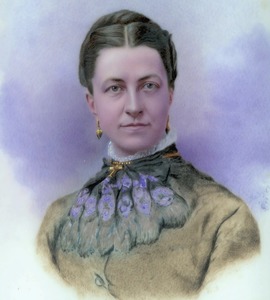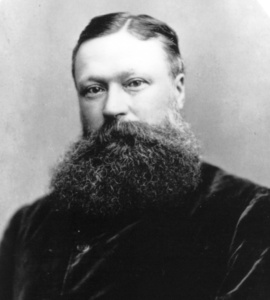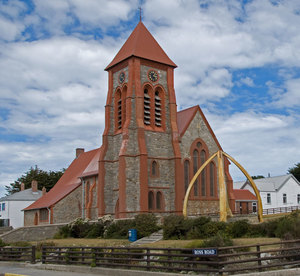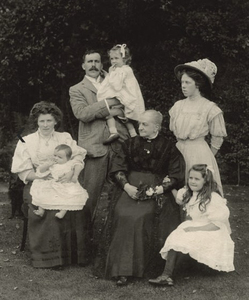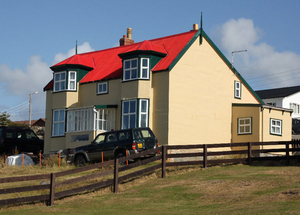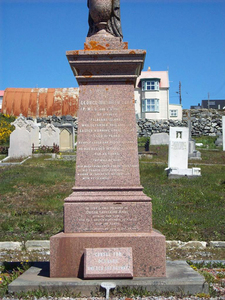DEAN, ORISSA CATHERINE ANNE
1840 - 1920 from India (also England)
benefactor, is thought to have been born in Orissa, India, the daughter of Thomas and Elizabeth Wotton, later of Newington. In 1862 she married George Markham Dean, born in 1837, the eldest son of JM DEAN and came to the Falkland Islands with him the following year. They had no children.
Orissa's diary for 1866 gives a very good idea of the life she led as a young woman. Small though Stanley was there was a large amount of socialising in which she bore her part, and the menus for dinner parties were very extensive. One such for 13 January says that there were six guests who sat down to cantatrice soup, curried oysters, roast of fowls, boiled tongue, boiled leg of mutton, steak and oyster pie, potatoes, peas, cabbage, bread and caper sauces, golden pudding, blancmange and custards. On another evening after a very similar menu they 'cleared away the table and had a dance'. She and her husband both rode, and she refers to the horses being fetched in from Mare Harbour and the man who brought them being given £1.
Orissa and George were very happy. Of George's birthday in March she says 'My darling Pet's birthday 29 years old, bless my own love' and of her own birthday 'Pet gave me a rosebud, I preferred it to any birthday gift he could have given me, bless him, he picked it in Packes garden'. Their fourth wedding anniversary in October led to the comment 'The 4th Anniversary of our wedding day, bless my Pet. I love him more than ever if possible'.
At this time George, with his brother Charles Montague (Monte) Dean (1847-1902) had taken over the running of the very successful family firm from their father who had retired to England. Orissa was very well informed about the business, and throughout the diary refers to 'our ship' arriving, or the fact that George had beaten his competitors by being 'out of the Narrows before any of them started' and secured the business of a passing vessel. Her diary records to whom she wrote on each outward mail, and that 'Pet wrote to Far [JM Dean] with the Lloyds and Underwriters lists' and also made 'the American and Danish Consular returns'. There was also a Dean store and ship's chandlers, for which George and his brother were responsible, and one entry records the fact that 'Pet took up two Whalers for making a disturbance in the Store, they have to appear tomorrow'. Both went to prison for four days. Another entry refers to the Gefle, a Swedish man-of-war, requiring six month's provisions.
In 1866 the Deans moved in to Stanley Cottage, one of the very first houses to be built in Stanley in the 1840s. Orissa's diary gives progress reports: 'The men very busy painting Stanley Cottage for us to move into, it will look very well. Pet and I have been up attending to the flowers in the greenhouse', and finally on 22 September: 'moved into Stanley Cottage and slept here, all nice and clean'. Two weeks later they held a house-warming, with a massive dinner menu for six guests, and everybody else invited for later. The move also involved sitting in a 'new pew' next day at church.
In 1869 George Dean leased Port Stephens and Albemarle land from government, his partners being his brother and father. In 1874 he added Port Edgar when CH Williams went out of business. The first manager was a Swiss missionary named HUNZIKER and sheep numbers rose considerably. The Deans also built Jubilee Villas in 1887 to commemorate Queen Victoria's Golden Jubilee.
William Luxton, a Royal Marine who had arrived in the Falklands in 1864, was employed by George Dean and it seems likely that his wife, Mary Ann, worked for Mrs. Dean. When Luxton died in September 1881 at the age of thirtynine, leaving his wife with three children, the Deans took the entire family under their wing and the children became the children that they had never had. When Orissa was widowed in 1888 it was a blow from which she never recovered. George Dean left her a wealthy woman, and the Luxton family were also remembered, he left the 'furnishings of a kitchen, a sittingroom and two bedrooms' to Mary Ann, and one thousand pounds on trust for her children. Orissa was responsible for sending John Luxton to London to be trained as a cabinet-maker, for giving Beatrice a grand wedding in 1892 (the first by banns in the newly consecrated Christ Church Cathedral), and William jun. went to work on the Dean farm at Port Stephens. Beatrice died in 1895 on Keppel Island after giving birth to her second child. Her husband, William Lewis left his daughter Orissa (Rissy) aged two and his new born son with his mother-in-law and Orissa Dean before leaving to live and work in Patagonia where he re-married. When he returned he took his son back with him but Rissy stayed in the Falklands. Although not formally adopted by Orissa Dean, Rissy was known as Rissy Lewis Dean and was to all intents and purposes her dearly loved daughter. William's wedding to Maud Smith was celebrated at Stanley Cottage in 1901, as was that of Rissy Lewis to Reginald POLE-EVANS in 1916.
When George Dean died in 1888 negotiations began almost immediately to sell the very extensive Dean businesses to the Falkland Islands Company, except for the farms, Port Stephens (sold later to the Falkland Islands Company), and Pebble Island. Orissa inherited all the proceeds of her husband's share in the family concerns, and his interests in the retained farms.
When Orissa arrived in the Islands the church was in the Exchange building and known as Holy Trinity. Here she played the harmonium nearly every Sunday for morning and evening services, until the church was destroyed by a peat slip in 1886. The services were then held in a sail loft, until Christ Church Cathedral was consecrated in early 1892. Orissa Dean was one of the major benefactors of the new cathedral, helping to raise money for the construction, and giving the west window, the turret clock and five bells as a lasting memorial to her husband. It was not only Christ Church Cathedral that was so generously supported by Orissa. In 1909 she had Cemetery Cottage built, and a plaque attached reads:
This cottage is erected by Mrs. George M. Dean for the caretaker of Stanley Cemetery, 1909, in loving memory of her dead husband George Markham Dean, her godchildren Beatrice Mary Lewis, George Thomas Luxton and all those who are sleeping their last long sleep in this resting place. Until the day breaks and the shadows flee away.
In 1880 a set of silver gilt and enamel tableware (to be found in the Museum today) was presented 'to Mrs. Geo. M. Dean by the Colonists as a mark of their appreciation of her kindness and charity to the sick and of her devotion generally to good works among the Settlers'.
In early 1896 Orissa Dean released Charles Anson from his mortgage of £8,294 on the property known as The Chartres, and on the same day Orissa and Charles Anson agreed to become partners, the name of the firm to be Dean and Anson, Charles Anson having sole responsibility for the management and Orissa Dean agreeing to pay him a salary of two hundred and fifty pounds per annum. The Ansons had lost two children in 1890 and thirteen years later they had a son. In 1905 they left the Falklands, and William Luxton moved from Port Stephens where he was head shepherd and sub-manager to become manager at The Chartres. William and Maud Luxton had three children, and Orissa Dean, whom they all called Dubbie, kept in very frequent telegraphic touch with them and with Rissy Pole-Evans at Port Howard, who also had three children, once the radio station was established at Fox Bay in 1918.
Orissa Dean died in September, 1920, after a long illness. She left her share and interest in Port Stephens and Port Edgar to her nephew WM Dean, (the son of Charles Dean) and The Chartres to William Luxton. In addition she left Stanley Cottage to William Luxton, and to various members of the Luxton family the four Jubilee villas, among a large number of bequests.
Editorial comment:
The Editor is grateful to Mr Scott Moncrieff for additional details of Orissa's parents.
Comments
Revisions
May 2019 Photograph of Cathedral added
January 2020 Three additional photographs added
August 2020 Text updated
